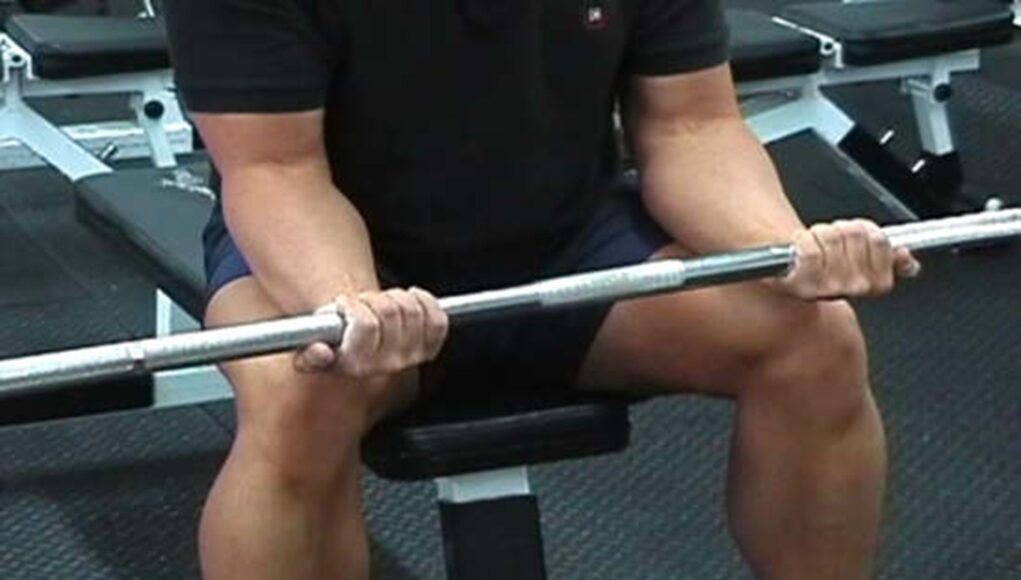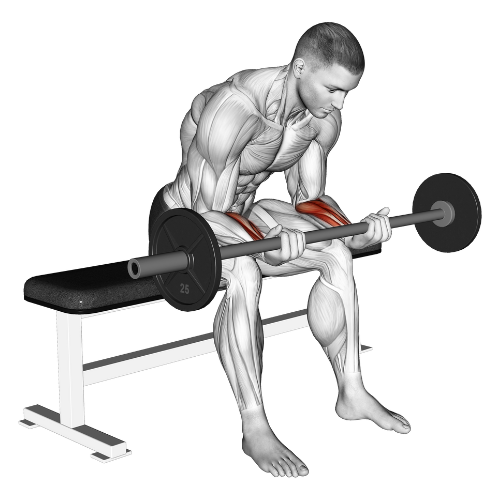Wrist Curls (Palms Up & Palms Down)
Wrist curls are a staple exercise for anyone looking to build strong, muscular forearms. They are simple yet highly effective in targeting the flexor and extensor muscles of the forearm, which are crucial for grip strength, overall arm aesthetics, and injury prevention.
Whether you’re a bodybuilder, an athlete, or someone looking to improve functional strength, incorporating wrist curls into your routine can lead to noticeable gains.
In this guide, we’ll break down the mechanics of wrist curls, the muscles they work, the difference between palms-up and palms-down variations, whether standing wrist curls are better than seated, and whether or not you should train them every day.
Palms Up Wrist Curl: Muscles Worked
The palms-up wrist curl, also known as the wrist flexion curl, primarily targets the wrist flexors, which include:
- Flexor Carpi Radialis – A muscle on the inner forearm responsible for wrist flexion and radial deviation.
- Flexor Carpi Ulnaris – Located along the pinky side of the forearm, this muscle helps with wrist flexion and ulnar deviation.
- Palmaris Longus – A long, thin muscle that aids in wrist flexion (although not everyone has it, as it’s absent in about 14% of the population).
- Flexor Digitorum Superficialis & Profundus – These muscles assist with wrist and finger flexion, playing a role in grip strength.
By strengthening these muscles, the palms-up wrist curl enhances grip endurance and improves performance in pulling exercises like deadlifts, pull-ups, and rows.
What Do Palms Down Wrist Curls Do?
The palms-down wrist curl, or wrist extension curl, focuses on the opposing muscles in the forearm—the wrist extensors:
- Extensor Carpi Radialis Longus & Brevis – These muscles help extend and stabilize the wrist during various movements.
- Extensor Carpi Ulnaris – Located on the outer side of the forearm, it assists with wrist extension and ulnar deviation.
- Extensor Digitorum – This muscle extends the fingers and also contributes to wrist stability.
Training these muscles is essential for balance in forearm development. Many people overlook the wrist extensors, leading to imbalances that can result in poor grip strength, increased risk of injury, and reduced overall arm aesthetics.
Palms-down wrist curls are particularly beneficial for athletes in sports that require strong wrist extension, such as tennis, rock climbing, and Olympic weightlifting.
Are Standing Wrist Curls Better Than Seated?
Both standing and seated wrist curls have their advantages, but which one is better depends on your goals and personal preference.
Seated Wrist Curls:
Better isolation – When seated, you can rest your forearms on a bench or your thighs, eliminating momentum and ensuring the forearm muscles do all the work.
More control – The stable position allows for a greater range of motion and better contraction of the target muscles.
Easier to go heavy – Since your arms are supported, you can use heavier weights with less risk of losing form.
Standing Wrist Curls:
Involves more stabilizer muscles – Since there’s no surface to support your forearms, your shoulders and core engage to maintain stability.
More functional strength – The movement more closely mimics real-world activities where your arms aren’t always supported.
More challenging for grip endurance – Holding the barbell or dumbbells without resting on a bench can improve overall forearm endurance.
For pure muscle isolation and hypertrophy, seated wrist curls are generally better. However, standing wrist curls are beneficial for those looking to improve grip strength and overall wrist stability. Ideally, incorporating both variations into your training program will yield the best results.
Can I Do Wrist Curls Every Day?
Wrist curls, like any resistance exercise, require proper recovery time to allow for muscle growth and prevent injury. Training them every day is generally not recommended for most people, as it can lead to overuse injuries, such as tendonitis or chronic muscle fatigue.
Here’s why daily wrist curls might not be a good idea:
- Forearms are involved in many other exercises – Heavy lifting, pulling movements, and even daily activities already engage the forearms, so excessive direct training can lead to overtraining.
- Risk of injury – Repeated stress on the wrist flexors and extensors without adequate rest increases the chance of tendon strain and joint discomfort.
- Muscle recovery is crucial for growth – Muscles grow during rest, not just during workouts. Overworking them can hinder progress rather than enhance it.
How Often Should You Train Wrist Curls?
Beginners: 1–2 times per week, focusing on light to moderate weight with higher reps (12–15 reps per set).
Intermediate to Advanced: 2–3 times per week, incorporating progressive overload while allowing at least 48 hours of recovery between sessions.
Athletes & Grip-Intensive Sports: Some individuals may train forearms more frequently, but they often vary intensity levels and incorporate different exercises rather than just wrist curls.
If you feel the need for daily forearm training, consider alternating between wrist flexion (palms up), wrist extension (palms down), grip work (like farmer’s carries), and wrist mobility exercises rather than repeating the same movement each day.
How to Perform Wrist Curls Correctly
Palms Up Wrist Curls:
- Sit on a bench with your forearms resting on your thighs, palms facing up, holding a barbell or dumbbells.
- Let the weight roll down to your fingertips, then curl your wrists upward, squeezing your forearms at the top.
- Lower the weight slowly, maintaining control throughout the movement.
- Repeat for 10–15 reps, aiming for 3–4 sets.
Palms Down Wrist Curls:
- Use the same setup as the palms-up version but with your palms facing down.
- Extend your wrists upward as far as possible, then lower the weight under control.
- Focus on a slow eccentric (lowering) phase to maximize muscle activation.
- Perform 10–15 reps for 3–4 sets.
Common Mistakes to Avoid
- Using excessive weight – This often leads to poor form and reduces the range of motion.
- Lifting with the arms instead of the wrists – Ensure that only the wrists move during the exercise.
- Skipping wrist extensors – Training both flexors and extensors prevents muscle imbalances.
- Not controlling the negative phase – Lowering the weight too quickly reduces muscle engagement and potential growth.
Conclusion
Wrist curls are a fundamental exercise for forearm development and grip strength. The palms-up variation primarily targets the wrist flexors, while the palms-down variation strengthens the wrist extensors.
Both standing and seated wrist curls have their benefits, and incorporating both can lead to well-rounded forearm development.
While wrist curls are highly effective, they should not be done every day due to the risk of overtraining.
Instead, a structured approach of training 2–3 times per week with proper recovery will yield the best results.
By performing wrist curls correctly and avoiding common mistakes, you can build stronger, more defined forearms that enhance both your performance and aesthetics.








